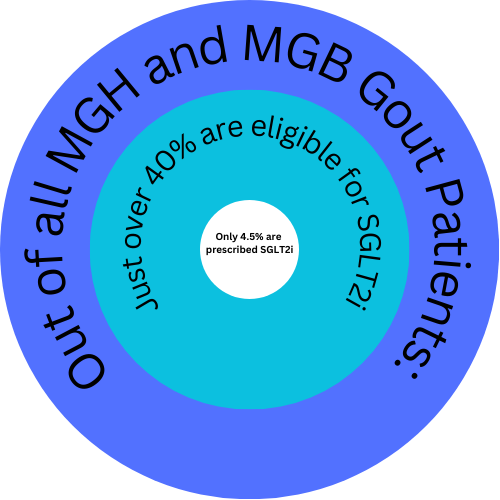This study followed and compared two groups of patients with gout and type 2 diabetes: those who started taking SGLT2i’s and those who started taking dipeptidyl peptidase 4 inhibitors (DPP-4i’s), another type of diabetes medication. Between the groups, the study compared the number of occurrent gout flares, the risk of myocardial infarction, and the risk of stroke. Overall, the study found that all three were lower for those who started on SGLT2i’s than for those who started on DPP-4i’s.
The Current State of Sodium-Glucose Cotransporter Type 2 Inhibitor Use Among Patients with Gout at a Tertiary Academic Healthcare System (November 2023)
This study looked at the percent of gout patients in the overall Mass General Brigham (MGB) system and the Mass General Hospital (MGH) rheumatology clinic that would qualify for SGLT2i medication by FDA standards and the percent of gout patients that actually are on SGLT2i medication. The study found that over 40% of gout patients across the rheumatology clinic in both MGH and MGB all qualified (had at least one FDA indication) for SGLT2i medication. However, only 10% of those who qualified (4.5% of the entire group) actually were prescribed SGLT2i medication.

This study compared gout patients that started SGLT2i medication to gout patients that started sulfonylurea (SFU), another type of diabetes medication. These patients were narrowed down to gout patients that had serum urate (SU) levels over 6 mg/dL and had SU measurements done before and after starting the medication. Data analysis showed that those who started SGLT2i had a significant decrease in serum urate levels, which is associated with improved gout outcomes, while those who started SFU did not have a significant decrease in serum urate levels.

This study looked at patients with type-2 diabetes in British Columbia, Canada that were using metformin, a type-2 diabetes medication, comparing those who started on SGLT2i medication versus those who started on other medications like DPP-4i, GLP1-RA, and sulfonylureas. The primary outcome being measured was the incidence, or the rate of new cases, of gout in each group. Overall, the study found that patients who started SGLT2i medication had a lower risk of new gout diagnoses than those who started other type 2 diabetes medication.
